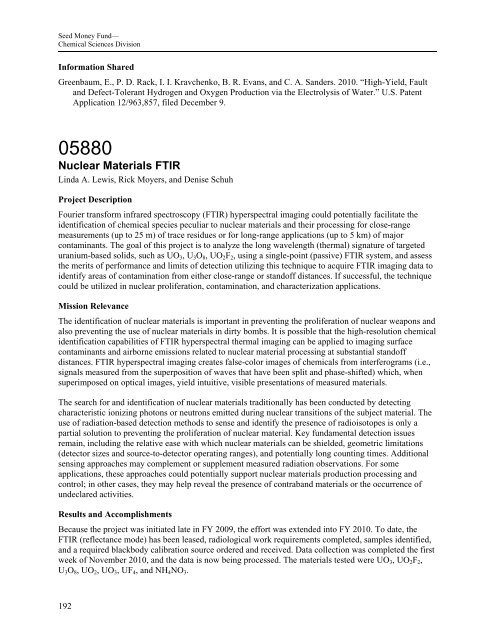FY2010 - Oak Ridge National Laboratory
FY2010 - Oak Ridge National Laboratory
FY2010 - Oak Ridge National Laboratory
Create successful ePaper yourself
Turn your PDF publications into a flip-book with our unique Google optimized e-Paper software.
Seed Money Fund—<br />
Chemical Sciences Division<br />
Information Shared<br />
Greenbaum, E., P. D. Rack, I. I. Kravchenko, B. R. Evans, and C. A. Sanders. 2010. “High-Yield, Fault<br />
and Defect-Tolerant Hydrogen and Oxygen Production via the Electrolysis of Water.” U.S. Patent<br />
Application 12/963,857, filed December 9.<br />
05880<br />
Nuclear Materials FTIR<br />
Linda A. Lewis, Rick Moyers, and Denise Schuh<br />
Project Description<br />
Fourier transform infrared spectroscopy (FTIR) hyperspectral imaging could potentially facilitate the<br />
identification of chemical species peculiar to nuclear materials and their processing for close-range<br />
measurements (up to 25 m) of trace residues or for long-range applications (up to 5 km) of major<br />
contaminants. The goal of this project is to analyze the long wavelength (thermal) signature of targeted<br />
uranium-based solids, such as UO 3 , U 3 O 8 , UO 2 F 2 , using a single-point (passive) FTIR system, and assess<br />
the merits of performance and limits of detection utilizing this technique to acquire FTIR imaging data to<br />
identify areas of contamination from either close-range or standoff distances. If successful, the technique<br />
could be utilized in nuclear proliferation, contamination, and characterization applications.<br />
Mission Relevance<br />
The identification of nuclear materials is important in preventing the proliferation of nuclear weapons and<br />
also preventing the use of nuclear materials in dirty bombs. It is possible that the high-resolution chemical<br />
identification capabilities of FTIR hyperspectral thermal imaging can be applied to imaging surface<br />
contaminants and airborne emissions related to nuclear material processing at substantial standoff<br />
distances. FTIR hyperspectral imaging creates false-color images of chemicals from interferograms (i.e.,<br />
signals measured from the superposition of waves that have been split and phase-shifted) which, when<br />
superimposed on optical images, yield intuitive, visible presentations of measured materials.<br />
The search for and identification of nuclear materials traditionally has been conducted by detecting<br />
characteristic ionizing photons or neutrons emitted during nuclear transitions of the subject material. The<br />
use of radiation-based detection methods to sense and identify the presence of radioisotopes is only a<br />
partial solution to preventing the proliferation of nuclear material. Key fundamental detection issues<br />
remain, including the relative ease with which nuclear materials can be shielded, geometric limitations<br />
(detector sizes and source-to-detector operating ranges), and potentially long counting times. Additional<br />
sensing approaches may complement or supplement measured radiation observations. For some<br />
applications, these approaches could potentially support nuclear materials production processing and<br />
control; in other cases, they may help reveal the presence of contraband materials or the occurrence of<br />
undeclared activities.<br />
Results and Accomplishments<br />
Because the project was initiated late in FY 2009, the effort was extended into FY 2010. To date, the<br />
FTIR (reflectance mode) has been leased, radiological work requirements completed, samples identified,<br />
and a required blackbody calibration source ordered and received. Data collection was completed the first<br />
week of November 2010, and the data is now being processed. The materials tested were UO 3 , UO 2 F 2 ,<br />
U 3 O 8 , UO 2 , UO 3 , UF 4 , and NH 4 NO 3 .<br />
192
















